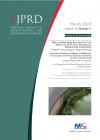European Journal of Prosthodontics and Restorative Dentistry

- Cover Date:
- March 2010
- Print ISSN:
- 0965-7452
- Vol:
- 18
- Issue:
- 1
Book Review - Esthetics with resin composite: basics and techniques
Book Review
Esthetics with resin composite: basics and techniques. Editor: Burkard Hugo. ISBN: 978-1- 85097-183-2. Quintessence. Hardback £158.00. 272 pages 1227 mostly colour illustrations.
There are few books that comprehensively detail the placement of anterior composite restorations in such a well-illustrated way. This book begins by immediately laying down the ground rules for anterior aesthetic restorations; the reader is introduced to various underlying principles such as the golden proportion, horizontal and vertical lines of reference and the visual effects of tooth shape. The second chapter initially considers the varying degrees of tooth preparation. This is an important interlude, and the argument for tooth preparation in certain situations (and how it will affect the aesthetic outcome) is well-delivered. The book does briefly discuss a number of resin composite systems, yet the author clearly favours one in particular (perhaps less well-known in the UK) over the others. The subsequent chapters move through the technical aspects of anterior composite placement using a fantastic series of clinical photographs (the accompanying DVD also provides clear footage of a few different anterior restorations being placed). Time is taken to discuss layering techniques and matrix adaptation. The author describes a useful technique for contouring and securing an interproximal matrix, but it would perhaps have been useful to see at least a couple of different approaches (not least in-case the reader does not have the same availability of materials). This was also the case when building up interproximal contacts – the author made frequent use of flowable composite, but it would have been a good idea to explain how to manage with a more traditional, more heavily-filled resin system. The second half of the book uses a good selection of clinical cases to display the use of composite, including hybrid techniques involving vital and non-vital bleaching. Despite recommendations for bleaching in the book, U.K.-based practitioners are encouraged to check the GDC guidance with respect to the use of hydrogen peroxidebased products. The book draws to a close with a section that discusses the repair of composites. I was happy to see this within the text, as it often stirs up a rather heated debate between clinicians and materials scientists. Nonetheless the advice seems perfectly appropriate. In conclusion, the book is an excellent introduction to anterior composite placement. My only minor criticism is that the author could have included a small section on how he placed his rubber dam – for most practitioners, a series of photos detailing the ligature technique would have been very useful.
James Field School of Dental Sciences Newcastle University
- Article Price
- £15.00
- Institution Article Price
- £
- Page Start
- 0
- Page End
- 0
- Authors
Articles from this issue
- Title
- Pg. Start
- Pg. End
- Effect of Noble Metal Alloy Post and Core Material on the Fracture Resistance of Endodontically Treated Teeth
- 2
- 7
- An Audit to Assess the Quality and Efficiency of Complete and Partial Dentures Delivered by Junior Hospital Staff
- 8
- 12
- Fracture Resistance of Endodontically Treated Teeth: Effect of Tooth Coloured Post Material and Surface Conditioning
- 23
- 30
- Dimensional Stability of Complete Denture Permanent Acrylic Resin Denture Bases; A Comparison of Dimensions Before and After a Second Curing Cycle.
- 33
- 38
- Is the Bond Between Acrylic Resin Denture Teeth and Denture Base Resin Stronger if They are Both Made by the Same Manufacturer?
- 39
- 41
- Decision Making Among Swedish General Dental Practitioners Concerning Prosthodontic Treatment Planning In a Shortened Dental Arch
- 43
- 47
